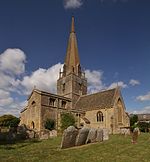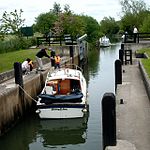Weald, Oxfordshire
Use British English from August 2015Villages in OxfordshireWest Oxfordshire District
Weald is a hamlet in Bampton civil parish in Oxfordshire, England. It lies about 0.7 miles (1.1 km) southwest of Bampton. The toponym Weald is from the Old English for "woodland". The place was recorded by name in the late 12th century when Osney Abbey acquired a house there. It was a separate township by the 13th century. In the 18th and 19th centuries the township included much of the southwest part of the town of Bampton itself. A large late 17th century manor house, Weald Manor, was remodelled at around 1730. It is a Grade II* listed building.
Excerpt from the Wikipedia article Weald, Oxfordshire (License: CC BY-SA 3.0, Authors).Weald, Oxfordshire
Weald Street, West Oxfordshire Bampton
Geographical coordinates (GPS) Address Nearby Places Show on map
Geographical coordinates (GPS)
| Latitude | Longitude |
|---|---|
| N 51.718 ° | E -1.554 ° |
Address
Weald Street
Weald Street
OX18 2HG West Oxfordshire, Bampton
England, United Kingdom
Open on Google Maps











